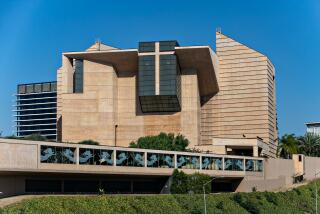Report indicts ‘60s counterculture in Catholic abuse cases
- Share via
Blame the flower children. That seems to be the chief conclusion of a new report about the Roman Catholic Church’s sexual abuse scandal. The study, undertaken by John Jay College of Criminal Justice at the request of America’s Catholic bishops, links the spike in child abuse by priests in the 1960s and ‘70s to “the importance given to young people and popular culture” — along with the emergence of the feminist movement, a “singles culture” and a growing acceptance of homosexuality. It also cites crime, drugs, an increase in premarital sexual behavior and divorce.
The problem with this conclusion isn’t that it absolves molesting priests of responsibility. Even the study’s authors wouldn’t go that far. Rather, the flaw with the theory is that it’s unsupported by any data or evidence. It thus detracts from the report’s other findings, which are based on empirical research. Indeed, aside from its implausible indictment of the ‘60s counterculture, the report is an enlightening analysis of an abominable chapter in the Roman Catholic Church’s history.
Drawing partly on a 2004 study, also by John Jay College, the report provides a detailed account of everything from the incidence of sexual abuse by priests to the age of victims to the relationship of sexual orientation to abuse. Some of the conclusions it draws from its data are debatable. For example, it suggests that only a minority of the abusers should be considered pedophiles, because most priests molested children older than 10 — even though most social scientists consider 13 to be a more accurate cutoff. But the data themselves are important. Especially striking is the dramatic decline in incidents of abuse over the last 25 years, a phenomenon obscured by the fact that so many examples of abuse have come to light recently. In explaining that decline, the report points to activism by victims’ advocates and tougher responses to abuse by bishops.
The report has generated criticism from Catholic conservatives, who object to its denial of a relationship between abuse and homosexuality, and victims’ advocates, who fault it for insufficiently emphasizing the complicity of bishops in covering up priestly abuse, and for its conclusion that abuse is essentially a thing of the past. Liberal Catholics will be discomfited by the finding that there is no link between celibacy and abuse. The critics need to confront the study’s evidence, not just its conclusions.
There are no moral shades of gray in the abuse of minors by Catholic clergymen, or in the concealment of such heinous behavior by the hierarchy. But it doesn’t excuse the abuse or the abusers to explore the realities of the phenomenon. That’s what the John Jay study was designed to do. And, with the exception of its broadside against the 1960s, it succeeds.
More to Read
A cure for the common opinion
Get thought-provoking perspectives with our weekly newsletter.
You may occasionally receive promotional content from the Los Angeles Times.









